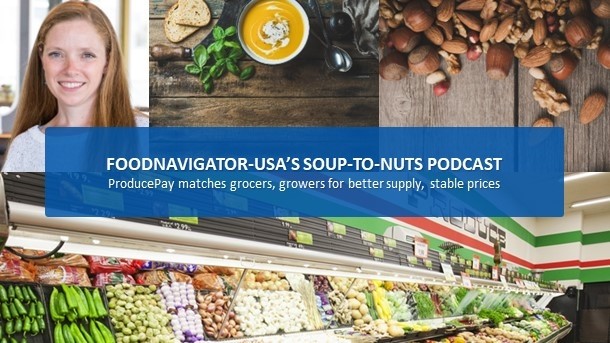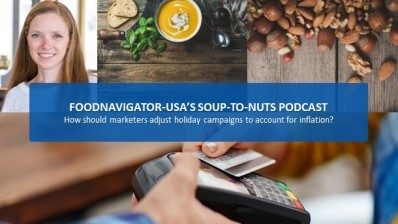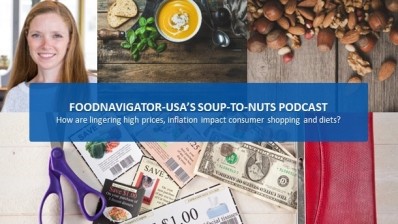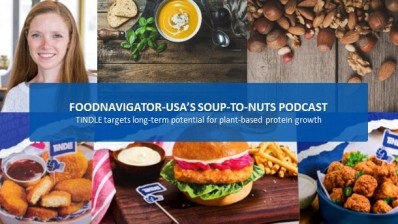Soup-To-Nuts Podcast: ProducePay matches grocers, growers for better supply, price stability

Nearly 40% of buyers say they struggle to find consistent growers from whom to purchase and 41% say they have trouble sourcing enough supply, according to a survey conducted for ProducePay, which is on a mission to create a more connected and sustainable produce supply chain.
Retailers are not alone in their frustration, according to the survey. About half of growers also report difficulty connecting with consistent buyers, which 45% say is stunting their business growth because they are unable to expand and diversity their portfolios.
In this episode of FoodNavigator-USA’s Soup-To-Nuts podcast, ProducePay CEO Pat McCullough shares how the ag fintech company is recreating – and shortening – global produce supply chains to address these pain points as well as reduce food and economic waste. He also explains how ProducePay is adding much needed transparency to produce supply chains and more equitably splitting financial risk across the value chain so that each stakeholder can more quickly and fairly achieve their goals.
[Editor’s note: Never miss an episode of FoodNavigator-USA’s Soup-To-Nuts podcast – subscribe today.]
By digitizing the produce supply chain, ProducePay helps smooth price volatility
A common thread uniting grocers and growers in their frustration finding reliable partners is the price volatility of produce, which swings wildly based on the growing cycle, weather, global supply and demand and other macro trends. McCullough explains this challenge is compounded by highly fragmented, analogue produce supply chains and a lack of planning foresight which favors spot markets – an inherently unreliable option that further complicates future long-term planning and ultimately business growth.
“Produce and meat and poultry are the highest customer satisfying parts of the grocery store, and also the most prone areas to be used as excuses for switching,” and so retailers are eager to provide a high quality selection that will attract consumers, McCullough said. But because produce is highly perishable and the supply chain is still largely analogue, he explained, the spot market for produce accounts for about 30% to 40% of given commodities.
“The spot market is too large for the design of this industry,” he added.
“Our view at ProducePay is if we can show the big retailers the benefit of planning their future produce supply, we’re going to be able to finance new land planting, with specifically first rights for the retailers that gave us the volume and price commitment. And then we will be able to deliver on the retailers wants, which is the right stuff at the right time at the right price and right quality,” he explained.
McCullough recognizes that retailers can’t predict with 100% certainty how much of each fruit and vegetable they will need in the next year – let alone five – because consumer whims and trends move so quickly. But, he argues, they can predict a core programmatic buy based on consumers’ most common and consistent purchases. And while daunting, taking this step would allow farmers to adjust their production to better meet demand.
ProducePay matches growers, retailers to tackle top concerns
To help grocers and growers meet in the middle, ProducePay has created a digital marketplace that directly connects both sides and addresses their top concerns.
“Produce pay set out to solve a couple of problems,” McCullough said. “The first problem was there is a tremendous amount of inefficiency and waste in both the produce industry but also the distribution and how things get commercialized, bought and sold.”
As a result, 40% of harvested produce perishes before it is consumed or processed, McCullough said.
“The second problem we set out to solve was two-thirds of the produce that's consumed in the US is imported from Latin America, and Latin American farmers are not treated in let's say, a fair, open, transparent, trusting way. There are random deductions taken off of their consignment shipments, there are price and terms negotiations, where they're taken advantage of because their buyers are offering them the working capital that's needed. Most importantly, the farm holds weather disease and global supply and demand, ie pricing risk through the entire vertical until it finally physically gets received at a grocery distribution center, where a retailer will sign off and assume those risks at that point,” said McCullough.
To address both of these problems, ProducePay has created a risk-sharing model that connects the retail grocer directly with the farm through one intermediary instead of four to six by creating commercial agreements with financing, with efficient transportation and quality information so that counterparties can receive that value and connect directly.
“We have several examples where we've connected that investment grade retail balance sheet, to the financial structures. We're creating that as a first of its kind type of structure,” McCullough said.
“We're able to do that because of our leverage with the farms because we've become their trusted partner advancing them capital and providing trade protection and access to customers in market,” McCullough said.
For retailers, these arrangements provide them with the produce they want at a price, quantity and time they want, he added.
Added benefits for farmers
ProducePay further reinforces farmers’ ability to deliver through the introduction late last year of Quick-Pay – the industry’s first payment service that pays growers within 24 hours, which allows them to avoid so called “pick and pack” arrangements where buyers front the costs of a grower’s shipment in exchange for set prices that might come in under market rate.
ProducePay is also creating new market opportunities for growers, such as the introduction of a carbon offset program for primary crops that go beyond large, securitized crops like wheat and soy in the US and the forestry sector.
ProducePay’s growth speaks to its need
ProducePay’s efforts to revolutionize produce supply chains and offer farmers more financial solutions are paying off – not just for growers and grocers, but also the company, which recently broke through profitability after growing its market share from $750m in 2020 to $2.5bn in 2022 and additional 200% in the first quarter of 2023.
Looking forward, the company is eager to build on this growth by expanding into Europe this year and eventually Morocco and South Africa as farming operations that support the European Market.





















